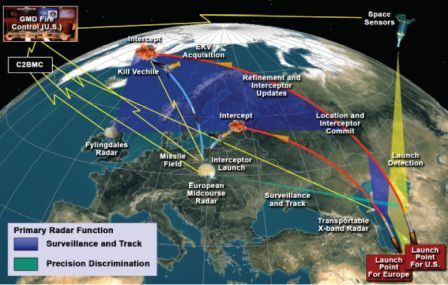
From Desmond Butler, AP: Major delays, cost overruns and critical technological problems are plaguing a missile defense system designed to protect the United States and Europe from an Iranian attack , Pentagon advisers and government investigators say about one of President Barack Obama’s top military programs.
The reports cast doubt on the shield, a politically sensitive issue at home and in relations with Russia. They say missile interceptors are running into production glitches, radars are underpowered and sensors cannot distinguish between warheads and other objects.
A report by the Defense Science Board, an advisory group to the Defense Department, came out late last year but received little notice. While it concludes there are "no fundamental roadblocks" to the system, it points out big problems without saying how they can be fixed.
Board members declined repeated requests for comment. Outside experts, including the Pentagon’s former chief weapons tester, Philip Coyle, say the issues raised in the report would require substantial and costly changes, if they can all be surmounted at all.
The second report, by Congress’ nonpartisan Government Accountability Office, was released Friday. . . .
Soon after Obama took office in 2009, he revamped the program as he looked to improve relations with Moscow. His plans called for slower interceptors that could address Iran’s medium-range missiles. The interceptors would be upgraded gradually over four phases, culminating in 2020 with newer versions, still in development, that the administration says will protect Europe and the United States. The early phases call for using Aegis radars on ships and a more powerful radar based in Turkey. Later phases call for moving Aegis radars to Romania and Poland.
The plans have gained momentum in Europe with the signing of basing agreements in Poland, Romania and Turkey, as well as backing by NATO. . . .
Congressional investigators said the Defense Department is committing to technologies before they are proven and that the administration is risking "performance shortfalls, unexpected cost increases, schedule delays and test problems."
Key parts of the system are already experiencing problems. For instance, the GAO report said pressure to meet Obama’s 2015 deadline to field the second phase of the system has led the Defense Department to order dozens of interceptors even though it’s not clear they will work. Testing isn’t expected to be completed until next year.
The report raised larger concerns for the interceptors planned for the last two stages.
On the third-stage interceptor, the report says critical technologies in its rocket motors had problems during testing that may require redesign. The report also criticizes the administration for setting out a timeline that calls for scheduling a test for the final interceptor a year before the military can confirm whether its design can work.
Similarly, the report says the military plans to install its radar in Romania before it is tested, and that the radar could interfere with Romanian cellphone, data, television and radio broadcasts unless it is altered. (graphic: CSIS)
Image: csis%204%2023%2012%20missile-defense-final_0.jpg
